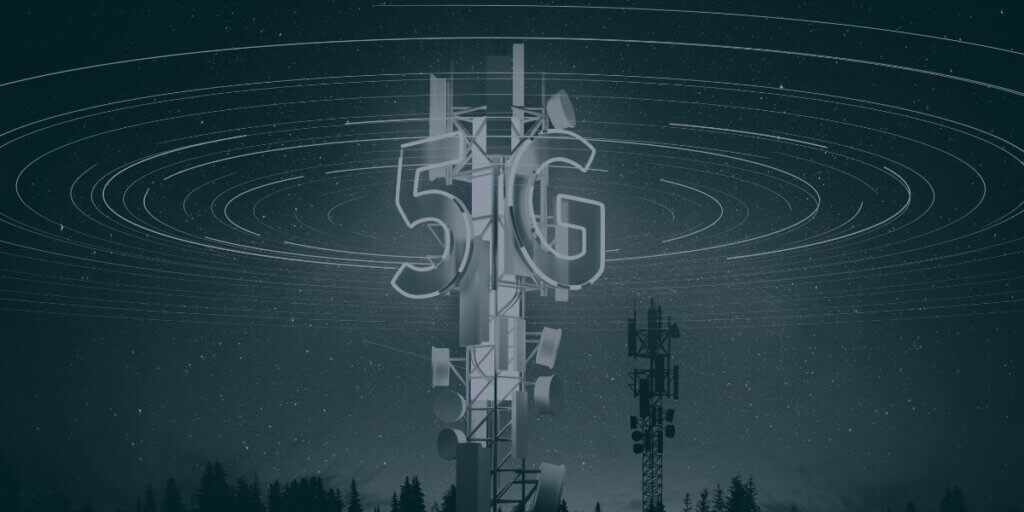What Are Data Caps? How to Avoid Overage Charges
Data caps are limits set by some internet providers on how much data you can use each month. Sometimes those data limits are very high (above 1 TB) and aren’t likely to affect your daily activities. But a low data cap (under 300 GB) may prevent you from HD streaming or gaming on the internet.
Ever settled in for a movie night, only to find your internet crawling at a snail’s pace? Or even worse, maybe you’ve opened an unexpected bill with hefty data overage charges!
You can avoid these unpleasant surprises if you understand data caps vs. unlimited data [1]. Read on to get all the information you need to protect yourself.
The Hidden Limit: Understanding Data Caps
Not every internet service provider (ISP) uses data caps [2]. But when they do, you need to know the potential drawbacks for your internet performance and your wallet.
Data caps determine the maximum amount of data your ISP allows you to use within a monthly billing cycle. Everything you do online – from sending emails to streaming videos – counts toward this limit.
How Data Caps Work
- Measurement: Your ISP tracks the total amount of data you send and receive.
- Limit: Once you hit your cap, consequences kick in (more on this later).
- Reset: Your data allowance refreshes at the start of each billing cycle.
Why Do ISPs Implement Data Caps?
- Network Management: Caps help prevent network congestion by discouraging excessive use [3].
- Tiered Pricing: Data caps allow ISPs to offer different plans at various price points.
- Revenue Generation: Some providers use caps to charge extra fees for heavy users.

Data caps limit your internet usage
What Does “Unlimited Data” Mean?
The term “unlimited" in internet plans often comes with an asterisk. While you can technically use as much data as you want, there’s usually a catch:
- Fair Usage Policy: Your speed might be reduced after reaching a certain threshold of data usage.
- Prioritization: Heavy users may see slower speeds during peak hours as their traffic is deprioritized.
- Hidden Limits: Some “unlimited" plans have soft caps that trigger internet speed throttling, often not clearly disclosed in marketing materials.
To truly understand what “unlimited" means for your plan:
- Read the Fine Print: Look for terms like “fair usage policy" or “network management practices" in your contract.
- Ask About Throttling: Check whether any data usage levels might trigger speed reductions or deprioritization.
- Understand Peak Hours: Learn if and how your service might be affected during high-traffic periods.
Remember, “unlimited" often means you won’t be charged overage fees, but it doesn’t always guarantee consistent high speeds throughout the month.
Data Caps or Monthly Data Allowances
Data caps and monthly data allowances are essentially the same thing – they both refer to the limit on how much data you can use in a billing cycle. Here’s a deeper look:
- Fixed Data Caps: A set amount of data, e.g., 250GB, 500GB, or 1TB per month.
- Roll-Over Plans: Some ISPs offer plans where unused data rolls over to the next month.
- Tiered Systems: Different plans with varying data allowances, allowing customers to choose based on their needs.
How these allowances work in practice:
- Tracking: Your ISP monitors your data usage throughout the billing cycle.
- Notifications: Some providers send alerts as you approach your limit (e.g., at 75%, 90%, and 100% usage).
- Consequences: Once exceeded, you may face overage charges, speed reductions, or complete cut-off (depending on your plan and provider).
Understanding your specific data allowance is crucial for managing your internet usage effectively and avoiding unexpected charges or service interruptions.

Unlimited data?
What Happens If You Go Over Your Data Caps?
Exceeding your data cap can lead to various consequences, depending on your ISP’s policies. Let’s explore the two most common outcomes.
Overage charges
Many ISPs implement overage charges when you surpass your data allowance. Here’s a deeper look at how this typically works:
- Notification System:
- You often receive alerts as you approach your limit (e.g., at 75%, 90%, and 100% usage).
- These notifications may come via email, text, or through your account portal.
- Charging Mechanism:
- Once you exceed the cap, you’re charged for additional data blocks.
- These blocks are usually in set increments, such as 50GB.
- Prices typically range from $10 to $15 per extra block.
- Billing Impact:
- Charges are added to your next monthly bill.
- There may be a maximum overage charge per month (e.g., $100 or $200).
- Examples:
- Mediacom charges $10 for each 50GB block over the limit.
- Xfinity charges $10 per 50GB, up to a maximum of $100 per month.
To avoid these charges:
- Monitor your usage carefully using your ISP’s tools or apps.
- Set up alerts to notify you when you’re nearing your limit.
- Consider upgrading your plan if you exceed your cap.
Throttling: When data caps slow you down
Instead of charging extra, some ISPs reduce your internet speed once you’ve exceeded your limit. This practice, known as throttling, can dramatically affect your online experience [4]:
- How Throttling Works:
- Your connection speed slows down significantly.
- Throttling can reduce your speed from high-speed broadband to as low as 1-3 Mbps.
- Impact of Throttling on Online Activities:
- Streaming: HD videos may buffer constantly or automatically switch to lower quality.
- Gaming: Online games may become unplayable due to high latency and slow speeds.
- Work: Video calls may become choppy, and file transfers can take much longer.
- General Browsing: Even loading simple web pages can become frustratingly slow.
- Duration:
- Throttling typically lasts until the start of your next billing cycle.
- Some ISPs may offer the option to purchase additional high-speed data to remove throttling [5].
- Identifying Throttling:
- Sudden, significant drops in speed after high usage.
- Consistently slow speeds that improve at the start of a new billing cycle.
While throttling doesn’t cost extra money, it can severely impact your ability to use the internet effectively. If you frequently experience throttling, consider upgrading to a higher data cap or an unlimited plan.

Throttling slows your connection
How much does unlimited data cost?
The cost of unlimited data plans varies widely depending on the provider, type of service (mobile or home internet), and included features. Here’s a detailed breakdown:
Cable Internet:
Ranges from $50 to $100+ per month
Examples:
Xfinity: $80/month for Gigabit plan with unlimited data
Spectrum: $69.99/month for standard plan (all plans unlimited)
Fiber Internet:
$30 to $120+ per month
Examples:
Google Fiber: $70/month for 1 Gig plan
Verizon Fios: $89.99/month for Gigabit Connection
5G Home Internet:
Often $50 to $70 per month
Examples:
T-Mobile Home Internet: $50/month
Verizon 5G Home Internet: $70/month (may be lower with qualifying mobile plan)

Overage charges
Factors affecting the price include:
- Provider Competition: Areas with more ISP options often have lower prices.
- Available Technology: Fiber and 5G plans may cost more but offer faster speeds [6].
- Bundled Services: Combining internet with TV or phone services can sometimes lower the overall cost.
- Contract Length: Some providers offer lower rates for longer commitments.
- Promotional Pricing: Introductory rates may be significantly lower but increase after a set period.
- Equipment Fees: Some plans include modem/router rental, while others charge extra.
Which Internet Providers Have Unlimited Data?
Many internet providers now offer unlimited data options, either as standard or as an add-on. Here’s a list of notable ISPs with unlimited data plans, along with some details about their offerings:
AT&T Fiber:
-
- Unlimited data on fiber plans
- Symmetrical speeds
Spectrum:
-
- All plans come with unlimited data
- No contracts required
Verizon Fios:
-
- Offers unlimited data on all fiber plans
- No overage charges
Metronet
-
- Unlimited data for all-fiber connections
- No contracts
Quantum Fiber:
-
- Offers unlimited data on all-fiber plans
- No contracts
Frontier Fiber:
-
- All plans come with unlimited data
- Available for both fiber and DSL services
Kinetic by Windstream:
-
- Offers unlimited data across all plans
- Available in rural and suburban areas
Fidium Fiber:
-
- Unlimited data on all plans
- No contracts required
WOW! (Wide Open West):
-
- Unlimited data on all plans
- No long-term contracts
Ziply Fiber:
-
- Unlimited data on all fiber plans
- Low pricing
Remember that availability varies by location, so check our list of providers in your specific area by entering your zip code for the most accurate information.

Fiber internet has no data caps
Which Internet Providers Have Data Caps?
While unlimited data is becoming more common, many ISPs still implement data caps on some or all of their plans. Here’s a detailed list of providers known for having data caps, along with specifics about their policies:
Xfinity:
-
- 1.2TB cap on most plans
- $10 charge for each additional 50GB block, up to $100 max per month
- Unlimited data available for an extra $30/month
Cox:
-
- 1.25TB cap on most plans
- $10 charge for each additional 50GB block
- Unlimited data available as an add-on for about $50/month
CenturyLink:
-
- 1TB cap on DSL plans
- Overage charges vary
Mediacom:
-
- Caps vary by plan, ranging from 400GB to 6TB
- $10 charge for each additional 50GB block
HughesNet (Satellite):
-
- Soft data caps ranging from 10GB to 200GB, depending on the plan
- Speeds reduced to 1-3 Mbps after exceeding the cap
Viasat (Satellite):
-
- Soft data cap around 850GB, much higher than most satellite plans
- Speeds will be prioritized lower during peak hours after exceeding the cap
WOW! (Wide Open West):
-
- 1.5 – 3 TB data caps are very generous
- Overage charges vary
It’s important to note that these caps and policies can change, and some providers may offer different terms in different service areas. Always check with the provider directly for the most up-to-date information on data caps and usage policies in your specific location.
When dealing with a provider that has data caps:
- Monitor your usage regularly using tools provided by your ISP
- Set up alerts to notify you when you’re approaching your limit
- Explore options for unlimited data add-ons if available
- Compare the cost of overage fees versus upgrading to a higher-tier or unlimited plan

Some 5G plans offer unlimited data
Which internet technology avoids data caps?
If you’re looking to steer clear of data caps altogether, some internet technologies are more likely to offer unlimited data than others. Here’s a breakdown of different internet types and their likelihood of having unlimited data:
- Fiber Optic Internet:
- Almost always offers unlimited data
- Fiber providers like Verizon Fios and AT&T Fiber don’t impose caps
- High-capacity nature of fiber networks makes it easier to provide unlimited data [7]
- Cable Internet:
- Increasingly offering unlimited data options
- Some providers like Spectrum have no data caps on any plans
- Others, like Xfinity, offer unlimited data as an add-on or on higher-tier plans
- 5G Fixed Wireless Home Internet:
- Often comes with unlimited data
- Providers like T-Mobile Home Internet and Verizon 5G Home Internet typically don’t have caps
- Still a relatively new technology, so availability may be limited
- Satellite Internet:
- Viasat now offers “unlimited data” which is actually a soft data cap much higher than usual satellite data caps and does not incur overage charges
- May still have “fair use" policies that could affect speeds during peak times
The Reality of Data Usage: How Much Do You Really Need?
Understanding your data usage per month is crucial for choosing the right internet plan. Here’s a detailed breakdown of common online activities and their data consumption:
Everyday Internet Activities
- Email: About 50 KB per email without attachments; can be much larger with attachments
- Web Browsing: Approximately 60 MB per hour of active browsing
- Social Media: Around 100 MB per hour, more if watching videos
Streaming and Entertainment
- Standard Definition (SD) Video: 1 GB per hour
- High Definition (HD) Video: 3 GB per hour
- 4K Ultra HD Video: Up to 7 GB per hour
- Music Streaming: About 150 MB per hour at high quality
- Online Gaming: 40-100 MB per hour for most games; downloads and updates can be several GB
Work and Productivity
- Video Conferencing: 500 MB to 2 GB per hour, depending on video quality
- Large File Downloads: Varies widely, can be several GB for software or large documents
- Cloud Backups: Initial backups can use several GB; subsequent backups use less
Smart Home Devices
- Smart Speakers: 50-200 MB per month for voice commands
- Security Cameras: 50-400 GB per month, depending on resolution and activity
- Smart Thermostats: 50-300 MB per month

Satellite internet now offers soft data caps
Monthly Usage Estimates
Light User: 100-500 GB per month
Emails, web browsing, social media, occasional streaming
Average User: 500 GB – 1 TB per month
Regular streaming, some gaming, work from home activities
Heavy User: 1 TB – 2 TB per month
Multiple users, 4K streaming, frequent gaming, large file transfers,
Power User: 2 TB+ per month
Multiple heavy users, constant 4K streaming, heavy gaming, large file uploads/downloads
Remember, these are estimates and actual usage can vary. To determine your needs:
- Check your past usage on your ISP’s account portal
- Use a data usage calculator provided by many ISPs
- Monitor your usage for a month to get a personal baseline
11 Tips to Avoid Hitting Your Data Cap
If you’re on a plan with a data cap, here are some ways to manage your usage and avoid exceeding your limit:
- Monitor Your Usage:
- Use your ISP’s tools or mobile apps to track data consumption
- Set up alerts for when you’re approaching your limit (e.g., at 75% and 90% usage)
- Optimize Streaming Quality:
- Adjust video quality settings on platforms like Netflix, YouTube, and Amazon Prime
- Use SD instead of HD when possible, especially on smaller screens
- Be mindful of auto-play features that can continue streaming without you realizing
- Download Content for Offline Use:
- Use features like Netflix’s download option to watch content offline
- Download music playlists for offline listening instead of streaming
- Update During Off-Peak Hours:
- Schedule large downloads or system updates for overnight hours
- Some ISPs offer “bonus bytes" or unmetered usage during certain hours
- Use Data Compression:
- Enable data-saving modes on web browsers and mobile devices
- Use VPNs that offer data compression features
- Be Mindful of Background Apps:
- Close apps that might be using data in the background
- Disable auto-play videos on social media apps
- Optimize Smart Home Devices:
- Adjust settings on security cameras to reduce unnecessary recordings
- Use lower resolution settings when high-quality video isn’t essential
- Consider Data Usage in Your Household:
- Educate family members about data caps and usage
- Implement household rules for high-data activities during peak usage periods
- Use Public Wi-Fi for Large Downloads:
- Take advantage of free Wi-Fi at libraries or cafes for big files
- Be sure to use a VPN for security when on public networks
- Check for Data Leaks:
- Ensure your Wi-Fi is password protected to prevent unauthorized use
- Look for unusually high data usage that might indicate a device issue or security problem
- Explore Add-Ons or Plan Changes:
- If you consistently approach your cap, look into data add-ons
- Compare the cost of overage fees versus upgrading to a higher data allowance or unlimited plan
If you just can’t avoid data caps on your internet plan, all of these tactics can reduce your data usage and avoid hitting your cap.

Find your best data plan
What Difference will Data Caps Make to Your Digital Life?
Data caps will affect your internet usage, especially if the caps are low. If you have a data cap below 500 GB or even below 1 TB, you may have to limit your heavy data usage. The more people use the internet in your home, and the more you all like HD streaming or online gaming, the more data caps may cramp your style.
Four takeaways to keep in mind:
Know Your Data Usage: Watch your data consumption to know how much data you need.
Understand Your Plan: Be clear on what “unlimited" really means and what happens if you exceed your cap.
Choose Wisely: Select a plan that balances cost with enough data for your household’s needs.
Stay Informed: Keep up with changes in data cap policies and new offerings from providers.
Sources
[1] Wikipedia.org. “Data Caps."
[2] TheVerge.com. “FCC Investigation on Data Caps."
[3] GeeksforGeeks.org. “What is Network Congestion?’
[4] Forbes.com. “What is Internet Throttling?"
[5] FCC.gov. “FCC Increases Broadband Speed Benchmark."
[6] Wikipedia.org. “5G."
[7] ElectronicFrontierFoundation.org. “The Case for Fiber to the Home."










